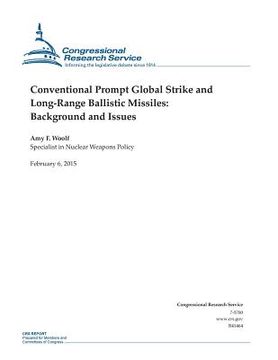Conventional Prompt Global Strike and Long-Range Ballistic Missiles: Background and Issues (en Inglés)
Reseña del libro "Conventional Prompt Global Strike and Long-Range Ballistic Missiles: Background and Issues (en Inglés)"
Conventional prompt global strike (CPGS) weapons would allow the United States to strike targets anywhere on Earth in as little as an hour. This capability may bolster U.S. efforts to deter and defeat adversaries by allowing the United States to attack high-value targets or "fleeting targets" at the start of or during a conflict. Congress has generally supported the PGS mission, but it has restricted funding and suggested some changes in funding for specific programs. CPGS weapons would not substitute for nuclear weapons, but would supplement U.S. conventional capabilities. They would provide a "niche" capability, with a small number of weapons directed against select, critical targets. Some analysts, however, have raised concerns about the possibility that U.S. adversaries might misinterpret the launch of a missile with conventional warheads and conclude that the missiles carry nuclear weapons. The U.S. Department of Defense (DOD) is considering a number of systems that might provide the United States with long-range strike capabilities. The Air Force and Navy have both considered deploying conventional warheads on their long-range ballistic missiles. The Navy sought to deploy conventional warheads on a small number of Trident II submarine-launched ballistic missiles. In FY2008, Congress rejected the requested funding for this program, but the Navy has continued to consider the possibility of deploying intermediate-range technologies for the prompt strike mission. The Air Force and the Defense Advanced Research Projects Agency (DARPA) are developing a hypersonic glide delivery vehicle that could deploy on a modified Peacekeeper land-based ballistic missile-a system known as the conventional strike missile (CSM). In FY2008, Congress created a single, combined fund to support research and development for the CPGS mission. Congress appropriated $65.4 million for this program in FY2014 and $95.6 million in FY2015; the Obama Administration has requested $78.8 million for FY2016. When Congress reviews the budget requests for CPGS weapons, it may question DOD's rationale for the mission, reviewing whether the United States might have to attack targets promptly at the start of or during a conflict, when it could not rely on forward-based land or naval forces. It might also review whether this capability would reduce U.S. reliance on nuclear weapons or whether, as some critics have asserted, it might upset stability and possibly increase the risk of a nuclear response to a U.S. attack. This risk derives, in part, from the possibility that nations detecting the launch of a U.S. PGS weapon would not be able to determine whether the weapon carried a nuclear or conventional warhead. Congress has raised concerns about this possibility in the past. While most analysts expected the Air Force to take the lead in deploying a hypersonic delivery system on a modified ballistic missile-a concept known as the conventional strike missile (CSM)-tests of the hypersonic vehicle known as the HTV-2 have not succeeded. An alternative glider, known as the AHW, may be deployed on missiles based at sea. Congress may review other weapons options for the CPGS mission, including bombers, cruise missiles, and possibly scramjets or other advanced technologies. Warheads deployed on boost-glide systems would not be affected by the 2010 New START Treaty because these are new types of strategic offensive arms. But those deployed in existing types of reentry vehicles on existing types of ballistic missiles would count against the treaty limits. This report will be updated as needed.

